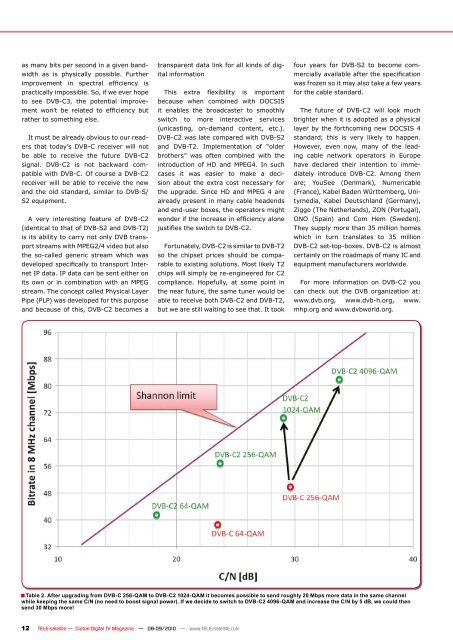Ultra HD - TELE-satellite International Magazine
Ultra HD - TELE-satellite International Magazine
Ultra HD - TELE-satellite International Magazine
You also want an ePaper? Increase the reach of your titles
YUMPU automatically turns print PDFs into web optimized ePapers that Google loves.
as many bits per second in a given bandwidth<br />
as is physically possible. Further<br />
improvement in spectral efficiency is<br />
practically impossible. So, if we ever hope<br />
to see DVB-C3, the potential improvement<br />
won’t be related to efficiency but<br />
rather to something else.<br />
It must be already obvious to our readers<br />
that today’s DVB-C receiver will not<br />
be able to receive the future DVB-C2<br />
signal. DVB-C2 is not backward compatible<br />
with DVB-C. Of course a DVB-C2<br />
receiver will be able to receive the new<br />
and the old standard, similar to DVB-S/<br />
S2 equipment.<br />
A very interesting feature of DVB-C2<br />
(identical to that of DVB-S2 and DVB-T2)<br />
is its ability to carry not only DVB transport<br />
streams with MPEG2/4 video but also<br />
the so-called generic stream which was<br />
developed specifically to transport Internet<br />
IP data. IP data can be sent either on<br />
its own or in combination with an MPEG<br />
stream. The concept called Physical Layer<br />
Pipe (PLP) was developed for this purpose<br />
and because of this, DVB-C2 becomes a<br />
■<br />
transparent data link for all kinds of digital<br />
information<br />
This extra flexibility is important<br />
because when combined with DOCSIS<br />
it enables the broadcaster to smoothly<br />
switch to more interactive services<br />
(unicasting, on-demand content, etc.).<br />
DVB-C2 was late compared with DVB-S2<br />
and DVB-T2. Implementation of “older<br />
brothers” was often combined with the<br />
introduction of <strong>HD</strong> and MPEG4. In such<br />
cases it was easier to make a decision<br />
about the extra cost necessary for<br />
the upgrade. Since <strong>HD</strong> and MPEG 4 are<br />
already present in many cable headends<br />
and end-user boxes, the operators might<br />
wonder if the increase in efficiency alone<br />
justifies the switch to DVB-C2.<br />
Fortunately, DVB-C2 is similar to DVB-T2<br />
so the chipset prices should be comparable<br />
to existing solutions. Most likely T2<br />
chips will simply be re-engineered for C2<br />
compliance. Hopefully, at some point in<br />
the near future, the same tuner would be<br />
able to receive both DVB-C2 and DVB-T2,<br />
but we are still waiting to see that. It took<br />
Table 2. After upgrading from DVB-C 256-QAM to DVB-C2 1024-QAM it becomes possible to send roughly 20 Mbps more data in the same channel<br />
while keeping the same C/N (no need to boost signal power). If we decide to switch to DVB-C2 4096-QAM and increase the C/N by 5 dB, we could then<br />
send 30 Mbps more!<br />
12 <strong>TELE</strong>-<strong>satellite</strong> — Global Digital TV <strong>Magazine</strong> — 08-09/2010 — www.<strong>TELE</strong>-<strong>satellite</strong>.com<br />
four years for DVB-S2 to become commercially<br />
available after the specification<br />
was frozen so it may also take a few years<br />
for the cable standard.<br />
The future of DVB-C2 will look much<br />
brighter when it is adopted as a physical<br />
layer by the forthcoming new DOCSIS 4<br />
standard; this is very likely to happen.<br />
However, even now, many of the leading<br />
cable network operators in Europe<br />
have declared their intention to immediately<br />
introduce DVB-C2. Among them<br />
are; YouSee (Denmark), Numericable<br />
(France), Kabel Baden Württemberg, Unitymedia,<br />
Kabel Deutschland (Germany),<br />
Ziggo (The Netherlands), ZON (Portugal),<br />
ONO (Spain) and Com Hem (Sweden).<br />
They supply more than 35 million homes<br />
which in turn translates to 35 million<br />
DVB-C2 set-top-boxes. DVB-C2 is almost<br />
certainly on the roadmaps of many IC and<br />
equipment manufacturers worldwide.<br />
For more information on DVB-C2 you<br />
can check out the DVB organization at:<br />
www.dvb.org, www.dvb-h.org, www.<br />
mhp.org and www.dvbworld.org.

















